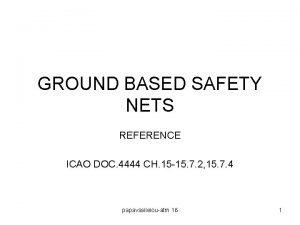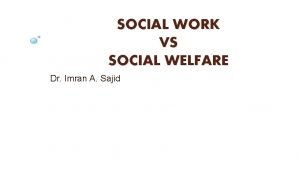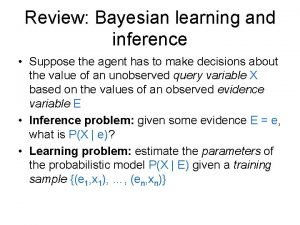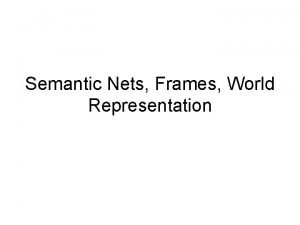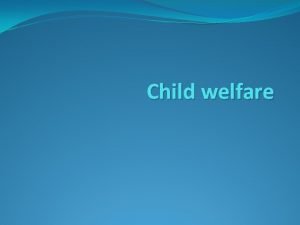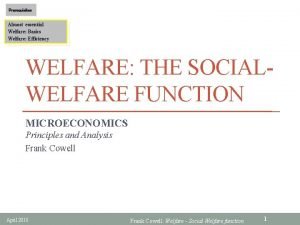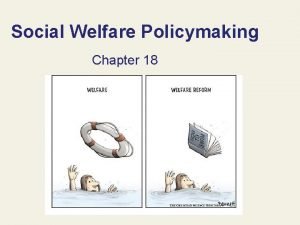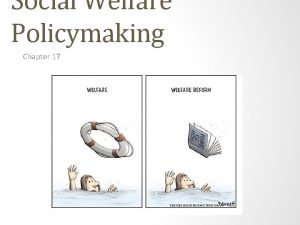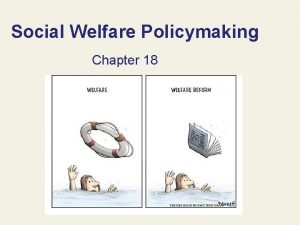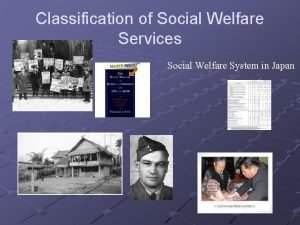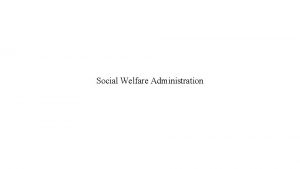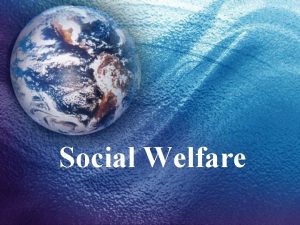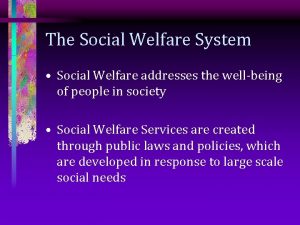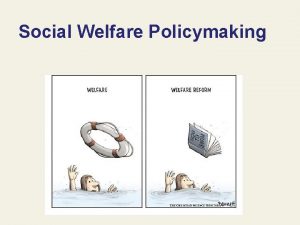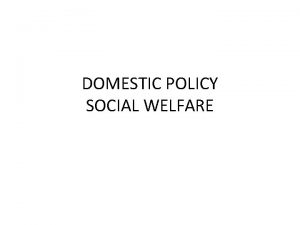Chapter 18 Social Safety Nets SOCIAL WELFARE A



















- Slides: 19

Chapter 18: Social Safety Nets

SOCIAL WELFARE A social welfare state is a society with a set of government programs that protect the minimum standards of living of families and individuals. All rich democracies have social welfare states.

• Key Ideas • Some safety net programs are administered directly from the federal government (ex. Social Security) and others are jointly administered from state and federal programs (ex. Medicaid and unemployment) • Entitlements: payments are made to people who meet certain eligibility requirements

Medicare, Medicaid, and CHIP: Three health insurance programs — Medicare, Medicaid, and the Children’s Health Insurance Program (CHIP) — together accounted for 22 percent of the budget in 2013, or $772 billion. • Nearly two-thirds of this amount, or $498 billion, went to Medicare, which provides health coverage to around 54 million people who are over the age of 65 or have disabilities. • The remainder of this category funds Medicaid and CHIP, which in a typical month provide health care or long-term care to about 70 million low-income children, parents, elderly people, and people with disabilities. Both Medicaid and CHIP require matching payments from the states. •

• Safety net programs p. 2 • About 12 percent of the federal budget in 2013, or $398 billion, supported programs that provide aid (other than health insurance or Social Security benefits) to individuals and families facing hardship. • Spending on safety net programs declined in both nominal and real terms between 2012 and 2013 as the economy continued to improve.

• Safety net programs • About 12 percent of the federal budget in 2013, or $398 billion, supported programs that provide aid (other than health insurance or Social Security benefits) to individuals and families facing hardship. • Spending on safety net programs declined in both nominal and real terms between 2012 and 2013 as the economy continued to improve.

• Safety net programs p. 3 1) the refundable portions of the Earned Income Tax Credit and Child Tax Credit, which assist low - and moderate-income working families through the tax code; 2) programs that provide cash payments to eligible individuals or households, including Supplemental Security Income for the elderly or disabled poor and unemployment insurance;

• Safety net programs p. 4 3) various forms of in-kind assistance for low-income families and individuals, including SNAP (food stamps), school meals, low-income housing assistance, child care assistance, and assistance in meeting home energy bills; 4) various other programs such as those that aid abused and neglected children.

Safety net programs p. 5 Such programs keep millions of people out of poverty each year. • • A CBPP analysis shows that government safety net programs kept some 41 million people out of poverty in 2012. • Without any government income assistance, either from safety net programs or other income supports like Social Security, the poverty rate would have been 29. 1 percent in 2012, nearly double the actual 16 percent

• Means-Tested • Benefits are distributed on the basis of need • Funded through general income tax revenues, rather than by payroll taxes • Food stamps • TANF=Temporary Assistance to Needy Families

Social Security • Social insurance • benefits based on contributions • Social Security • Funded by payroll tax • Due to an aging population, Social Security will run a deficit unless reforms are made.

Social Security cont… • Democrats favor small reforms. • Republicans favor a major overhaul, specifically privatizing individual retirement funds.

Medicare • Entitlement program for retirees and the disabled • Prescription drug benefit began in 2006 • One of the most costly federal programs • Payments are a recurring problem

Do Social Insurance Programs Work? • Successes • Problems

• Means-Tested Programs (Welfare) • Unpopularity • Food of previous AFDC program Stamps • Medicaid • Supplemental Security Income • The Earned Income Tax Credit

Welfare Block Grants • Results • Pro=welfare state • Con=About roles have diminished in every 20% of those who left the welfare roles between 1997 -2001 returned to them. =Because pay for entry-level positions is so low, very few former welfare recipients have been able to rise above the poverty line.

How the American Welfare State Compares with Others • All modern capitalist countries have social welfare states. • Welfare states range from low-benefit, targeted types (minimal or liberal welfare states) to high-benefit, universal types (developed or social democratic welfare states). • The United States is very close to being at the minimum end of the spectrum.

• Why the American Welfare State Is Different p. 2 Compared with other rich democracies, the American welfare state: • is much less costly • covers fewer people • favors the elderly • is less redistributive • requires less of private employers • does not include universal healthcare

Why the American Welfare State Is Different p. 3 • Constitutional rules • Racial and ethnic diversity • Political culture • Business power • Weak labor unions
 Icao 4444
Icao 4444 Safety nets must be drop tested
Safety nets must be drop tested Social welfare vs social work
Social welfare vs social work Cpi care welfare safety security
Cpi care welfare safety security Bayes nets
Bayes nets Represent solid figures using nets
Represent solid figures using nets Partitioned semantic nets in artificial intelligence
Partitioned semantic nets in artificial intelligence Surface area using nets
Surface area using nets Nets and drawings for visualizing geometry
Nets and drawings for visualizing geometry Petri nets properties analysis and applications
Petri nets properties analysis and applications Net triangular prism
Net triangular prism Nets church planting
Nets church planting List the 4 nets for better internet searching.
List the 4 nets for better internet searching. Lesson 1 nets and drawings for visualizing geometry
Lesson 1 nets and drawings for visualizing geometry Semantic nets and frames
Semantic nets and frames Nets and drawings for visualizing geometry
Nets and drawings for visualizing geometry Nets and drawings for visualizing geometry
Nets and drawings for visualizing geometry Nets blox
Nets blox Crystallography
Crystallography Representational adequacy
Representational adequacy
